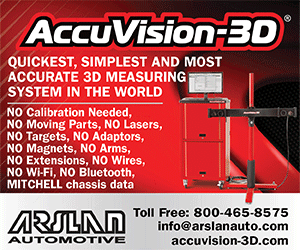
By Jeff Sanford
Toronto, Ontario — May 23, 2016 — This past week San Diego-based technology provider Mitchell International released its industry trends report for the first quarter of 2016 (please see “Mitchell issues Industry Trends Report for Q2” for more on this). Included in the report is an analysis of sales data by Greg Horn, Vice President of Industry Relations at Mitchell, which suggests a couple of tips for improving cycle time in a collision repair facility.
Horn analyzed data from a typical shop from the perspective of “cost of repair” as this data falls on a natural distribution curve. Viewing data as it is fitted to a “distribution curve” is a standard bit of statistical method. Horn likes to view data of a shop’s business in terms of the cost of the repair divided up into $500 segments.
“One of those key insights remains very valuable to me today: Whether you operate a repair shop, write estimates for an insurance company or are an independent appraiser, showing how claims volume falls within $500 increments can provide key insight into how your business measures against the industry, or how your shop compares against other shops,” says Horn.
Viewing claims distribution data reveals some interesting points. Horn notes that, “In today’s claims industry, more than 50 percent of all claims have a gross severity (not taking out deductible) of less than $2,500 … What is truly surprising is that just under 5 percent of claims have a gross severity of less than $500. On average, those claims have just over one part replaced, at an average cost of $116,” says Horn.
In a follow-up interview with Collision Repair magazine, Horn expanded on his analysis. “I think the percentage of estimates under $2,500 was surprising. Any time claims executives or collision shop managers see such a big volume of claims in such a tight distribution, they should explore the data to assure they are handling estimates in the most efficient way possible,” he says. “With the cost of a staff appraiser assignment around $200, ask yourself these questions: Are those the assignments that should be seen by a staff appraiser? Or should some other, more cost-effective method be used?
In the interview, Horn explained the importance of those smaller claim jobs: “Writing estimates on claims under $500 can eat up time for a shop, but it’s also a chance to win over a new customer. How that customer perceives your attentiveness and customer service may help you gain his next collision repair. While many insurance companies can avoid appraisal costs on smaller estimates by using a photo based written estimate, the cost of writing an appraisal for the shop may not be avoidable as the appraisal is an important element of the shop management system; it can also be an opportunity to upsell different repairs, PDR to take out small door dings for example,” says Horn.
Another thing shop owners can use data to analyze is to look at “regions or offices of insurance companies, as well as the location of the individual appraiser over time.” According to Horn, “Some direct repair shops and appraisers (both staff and IA’s) are unfairly penalized because the distribution of claims severity leans more towards pricier claims. Their production is lower, their supplement rate is above average, and the average severity is higher. This is not because the appraiser is less accurate, but because the appraiser has written appraisals on more heavily-damaged vehicles.”
Another suggestion supported by the data according to Horn: “Additionally, one should note the aforementioned fact that more than 50 percent of claims have an average severity of less than $2,500. This means that there are usually more repairable panels in today’s claims than on heavier-severity claims, and repair decisions and accuracy are extremely important. Lower cost claims yield more repairable bumpers, and repairs can be done faster than replacements.”
Horn also finds that “bumpers are present in 72 percent of repairable claims.” As a result the repairability of bumper covers in “claims less than $2,500 is even greater than on high-cost/higher-damage claims.” Claims under $2,500 will have more lightly-damaged bumper covers that can be repaired. “Based on that, are the appraisers who are seeing claims under $2,500 at the leading edge of bumper repair education? They should be, as bumper repair education (and fixing more covers) can lead to greater efficiency for a shop and lower claims costs for insurers,” says Horn
When asked what the latest “need-to-know” information on bumpers is today, Horn notes a study he did in an earlier trends report that indicated “the maximum average hours devoted to bumper cover repair tops out at 2.6 hours, regardless of the cost of the replacement cover,” says Horn. “The newest plastic repair products from 3M provide excellent repairs and are an important tool in pushing the envelope on quality bumper repairs. Shops can improve profit margin and decrease cycle time by improving their bumper repair frequency.” As well, says Horn, “Sensor knowledge regarding proper reinstallation of the sensors or the maximum thickness of paint that can be added to the surface of a sensor and still have that sensor function properly is important. That type of detailed information can be found in Mitchell’s Tech Advisor software.”




















